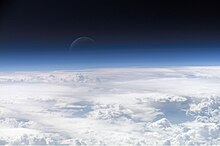User:ArthurXZY/TWA/Earth/2
The Earth is the third planet from the Sun. It is one of the four terrestrial planets in our Solar System. This means most of its mass is solid. The other three are Mercury, Venus, and Mars. The Earth is also called the Blue Planet, "Planet Earth", and "Terra".
The Earth is home to millions of species of plants and animals, including humans. Earth is the only planet in the galaxy known to support life. Earth has many places that are suitable for humans to live in, although some areas of the planet can are dangerous or uninhabitable.
Science shows that Earth formed around 4.5 billion years ago. The organisms that live on Earth have completely changed its air (atmosphere); this is called a biosphere.
71% of Earth's surface is covered in salt water oceans. Earth is the only place in the Solar System where liquid water is known to exist at present. The other 29% is made of rocky land in the shape of continents and islands.
Earth interacts with other objects in the Solar System, particularly the Sun and the Moon. The Earth orbits the Sun roughly once every 365.25 days. One spin is called a 'day' and one orbit around the Sun is called a 'year'. This is why there are 365 days in a year, but a leap day added to the calendar once every 4 years.[1]

Shape and structure
[edit]Earth is a terrestrial planet. This means it is made up of solid rock unlike a gas giant such as Jupiter. It is the largest out of the four terrestrial planets in mass and diameter. The Earth's shape is an oblate spheroid. This means it is basically a sphere but it bulges around the middle. The circumference of the Earth is about 40,000 kilometers; the average width of the Earth is about 12,700 kilometers. The highest point on Earth is the peak of Mount Everest at 8,848 meters above sea level. The lowest natural point is the bottom of the Mariana Trench at 10,911 meters below sea level. Because of the bulge at the middle or the equator, the farthest point from the Earth's center is the top of Mount Chimborazo in Ecuador.[2]
Inside, the Earth is similar to the other terrestrial planets. It has an outer, solid rock layer called the crust. Everything that lives on Earth is on top of the crust. Below that is a layer of thick, semi-liquid rock called the mantle. Under that is a thin liquid layer called the outer core and then the solid iron inner core. The thickness of the crust changes. On land the average is between 30–50 kilometers thick. Under the oceans in some places it is only 6 kilometers thick.[3]
Tectonic plates
[edit]
Surface
[edit]
Atmosphere
[edit]
Weather, climate, and water cycle
[edit]
Orbit and rotation
[edit]The Earth takes about 24 hours to complete one day and about 365 days to complete a year. Actually, the Earth take 365.24 days to revolve around the sun. After every four years, an extra day is added, and the year has 366 days. This is a leap year. The Earth is, on average, 150 million kilometers away from the Sun, and moving at a speed of 30 kilometers a second or 108,000 miles an hour. The Moon orbits the Earth at an average distance of 250,000 miles. It is tidally locked to Earth, which means it always has the same side facing the Earth. It takes roughly one month to complete one orbit. The Earth is part of the Solar System and orbits the sun along with thousands of small objects and eight planets. The Sun, and therefore the Solar System, are currently traveling through the Orion Arm of the Milky Way Galaxy and will be for approximately the next 10,000 years.[8]
References
- ^ Gnawledge, O'penn. "Planet Earth in the Balance of History". Science and Nature Journal. https://SandNjournal.com/Earthinthebalance. March 21, 20. Retrieved April 24th, 2013.
- ^ "Origin of the Moon and Earth". Reisch, Maggy. Nature.com: Volume 10:2, p.19-27. http://www.nature.com/102/Reisch/Earth. Retrieved 2023-07-28.
- ^ "Tectonic plates. Shifting Sands". Roberts, Paul. Harvard University Press. http://www.harvard.edu/roberts/shifting. Retrieved 2023-07-28.
- ^ Toshiro Tanimoto. "Crustal of the Earth". American Geophysical Union. Retrieved 2023-08-02.
- ^ "The Crust". Alphonz, Edgar. Oregon State University. http://www.osu.edu/Alphonz/Crust. Retrieved 2023-07-03.
- ^ "NASA - Earth's atmosphere". NASA Student Guides. http://www.nasa.gov/student/atmosphere. Retrieved 2023-08-06.
- ^ "What causes weather?". NASA Student Guides. http://www.nasa.gov/student/weather. Retrieved 2023-08-06
- ^ "Earth's in the Milky Way". NASA Student Guides. http://www.nasa.gov/student/milkyway. Retrieved 2023-08-06.

